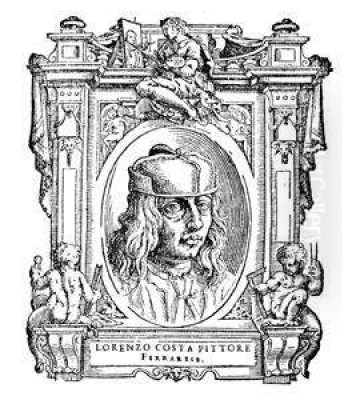
Lorenzo Costa the Elder (c. 1460 – 5 March 1535) stands as a significant, if sometimes overlooked, figure in the rich tapestry of the Italian Renaissance. A painter whose career bridged the artistic developments of Ferrara, Bologna, and Mantua, Costa's work is characterized by a gentle lyricism, a subtle understanding of human emotion, and a capacity to absorb and synthesize various influential styles. His journey from the somewhat austere traditions of his native Ferrara to the more sophisticated and humanistic courts of Bologna and Mantua reflects the dynamic artistic exchanges of the period. This article will delve into the life, works, influences, and legacy of this pivotal artist.
Early Life and Ferrarese Foundations
Born in Ferrara around 1460, Lorenzo Costa emerged from an artistic environment dominated by formidable talents. The Ferrarese school of painting, active from the mid-15th century, was known for its sharp linearity, expressive intensity, and often intricate, jewel-like detail. Figures like Cosimo Tura, the founder of the school, and Francesco del Cossa, were instrumental in establishing this distinctive style, often characterized by a certain wiriness in figures and a dramatic, sometimes unsettling, energy.
It is highly probable that Costa's initial training was under the aegis of Cosimo Tura, or at least heavily influenced by his workshop. Another significant early influence was Ercole de' Roberti, a slightly older contemporary who also hailed from Ferrara. Roberti, himself a pupil of Tura and Cossa, developed a style that, while retaining Ferrarese intensity, began to explore greater naturalism and emotional depth. Costa would have absorbed these local traditions, learning the meticulous techniques and the expressive potential of the Ferrarese approach. His early works, though few definitively survive or are identified from this specific period, would likely have borne the hallmarks of this rigorous, somewhat Gothic-inflected Renaissance style.
The artistic milieu of Ferrara was not isolated. The Este court, rulers of Ferrara, were significant patrons of the arts, fostering an environment where artists could flourish and where influences from other Italian centers could permeate. This foundational period in Ferrara provided Costa with the technical skills and artistic vocabulary that he would later adapt and transform.
The Bolognese Period: Collaboration and Stylistic Evolution
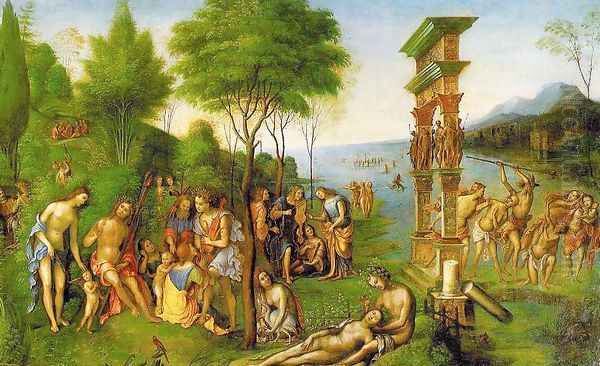
Around 1483, Lorenzo Costa relocated to Bologna, a city with its own burgeoning artistic scene and one that would prove crucial for his development. This move marked a significant turning point in his career. In Bologna, he encountered and began a long and fruitful collaboration with Francesco Francia (Francesco Raibolini), a painter who had initially trained as a goldsmith. This partnership was mutually beneficial and deeply influential.
Francia's style was characterized by a softer, more Umbrian sensibility, likely influenced by artists such as Pietro Perugino, whose work was gaining prominence throughout Italy for its gentle piety and harmonious compositions. The interaction between Costa's Ferrarese dynamism and Francia's more lyrical approach led to a significant evolution in Costa's art. He began to temper the sometimes harsh linearity of his Ferrarese training, embracing a more rounded modeling of figures, a softer application of paint, and a greater emphasis on atmospheric effects.
During his time in Bologna, which lasted for over two decades, Costa became a leading painter. He received numerous important commissions, particularly from the powerful Bentivoglio family, who were the de facto rulers of Bologna. For them, and for various ecclesiastical institutions, he executed altarpieces, devotional paintings, and frescoes. One of his most notable commissions from this period was for the Bentivoglio Chapel in the church of San Giacomo Maggiore. Here, he painted frescoes depicting the Triumphs of Fame and Death (circa 1490) and the impressive Madonna and Child Enthroned with Members of the Bentivoglio Family (1488). This latter work is a prime example of his Bolognese style, showcasing his ability to integrate portraiture within a sacred scene, rendering the figures with a newfound softness and psychological presence.
Other significant works from his Bolognese period include the Madonna and Child with Saints for the church of San Petronio (1492) and various altarpieces for San Giovanni in Monte, such as the Coronation of the Virgin with Saints. These paintings demonstrate his growing mastery of composition, his refined use of color, and his ability to convey tender emotions. His style became increasingly characterized by a gentle, almost melancholic grace, a departure from the more robust art of his Ferrarese predecessors. The influence of Perugino, perhaps transmitted through Francia or direct observation, is palpable in the serene expressions and balanced compositions of these works.
The Mantuan Court: A New Chapter
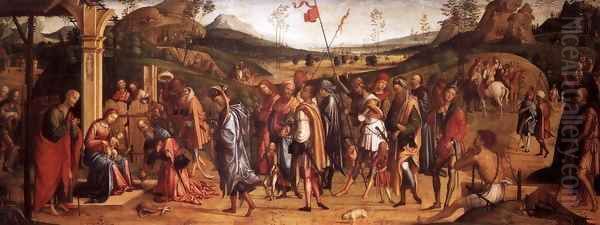
In 1506, a new and prestigious opportunity arose for Lorenzo Costa. Isabella d'Este, the highly cultured Marchesa of Mantua and a renowned patron of the arts, invited him to the Mantuan court. He was to succeed the recently deceased Andrea Mantegna, one of the giants of the Early Renaissance, as court painter to her husband, Francesco II Gonzaga, Marquess of Mantua. This appointment was a testament to Costa's established reputation.
Mantegna's artistic legacy in Mantua was formidable, characterized by its classical rigor, mastery of perspective, and sculptural solidity. While Costa respected Mantegna's achievements, his own artistic temperament was different. In Mantua, Costa's style continued to evolve, absorbing the sophisticated humanist atmosphere of the Gonzaga court. He produced a variety of works, including mythological scenes, allegories, and portraits, in addition to religious paintings.
One of his most famous commissions in Mantua was for Isabella d'Este's Studiolo in the Ducal Palace. For this private study, adorned with allegorical paintings by leading artists, Costa contributed Isabella d'Este in the Kingdom of Love (also known as The Reign of Comus or Allegory of the Court of Isabella d'Este), completed around 1504-1506 (though some sources suggest it was painted for the Studiolo around 1511, after Perugino's Combat of Love and Chastity). This work, now in the Louvre, is a complex allegorical scene filled with numerous figures, showcasing his ability to handle intricate narratives and create a poetic, dreamlike atmosphere. He also painted The Reign of Comus, based on a design by Mantegna, for the same Studiolo.
During his Mantuan period, Costa's paintings often displayed an increased elegance and a more fluid handling of paint. The influence of Venetian painting, particularly the work of artists like Giovanni Bellini and the emerging Giorgione, may have played a role. Giorgione, a younger contemporary, was revolutionizing Venetian art with his emphasis on mood, color, and enigmatic subjects. While direct contact is speculative, the general artistic currents of the time favored a softer, more atmospheric approach, which resonated with Costa's own inclinations. His work from this period, such as A Concert (c. 1485-1495, National Gallery, London, though its dating is debated and sometimes placed earlier in his Bolognese period), exemplifies this sensitivity to mood and human interaction, capturing the introspective expressions of the musicians.
Costa remained in Mantua for the rest of his life, serving the Gonzaga family with distinction. He died there on March 5, 1535, leaving behind a significant body of work and a lasting artistic legacy.
Artistic Style and Thematic Range
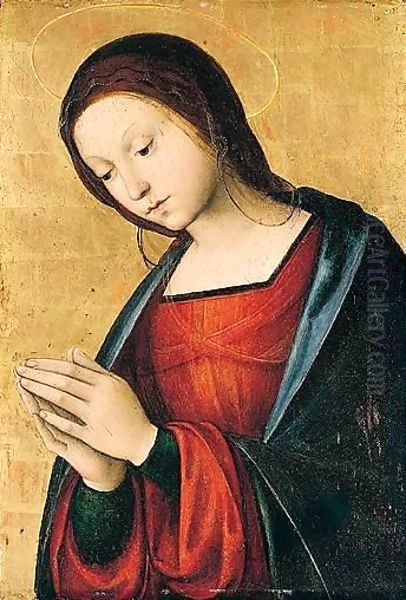
Lorenzo Costa's artistic style is a fascinating synthesis of regional traditions and personal innovation. He began with the linear precision and expressive intensity of the Ferrarese school, exemplified by Tura and Roberti. In Bologna, through his association with Francia and exposure to Umbrian influences (like Perugino), his style softened considerably. Figures became more rounded, compositions more harmonious, and a gentle, often melancholic, lyricism pervaded his work. He developed a delicate sfumato, blurring contours to create a softer, more atmospheric effect, and his color palettes became richer and more nuanced.
In Mantua, his style gained further refinement and elegance. While he never fully adopted the heroic classicism of Mantegna, he responded to the humanist environment of the court by creating sophisticated allegorical and mythological scenes. His figures often possess a graceful, elongated quality, and his landscapes, though typically serving as backdrops, are rendered with a sensitivity to light and atmosphere that contributes to the overall mood of the paintings.
Costa's thematic range was broad. He was a prolific painter of religious subjects, including numerous altarpieces of the Madonna and Child with saints, scenes from the lives of saints, and larger narrative frescoes. His devotional paintings are characterized by their sincere piety and tender emotionality. He also excelled in portraiture, as seen in the Bentivoglio altarpiece and other individual portraits, capturing the likeness and character of his sitters with subtlety. His mythological and allegorical works for the Mantuan court demonstrate his engagement with classical themes and humanist thought. Works like The Concert also show his interest in genre-like scenes, capturing moments of everyday life (albeit idealized) with psychological insight.
Notable Works: A Closer Look
Several key works highlight Lorenzo Costa's artistic achievements and stylistic development:
_Madonna and Child Enthroned with Members of the Bentivoglio Family_ (1488, Bentivoglio Chapel, San Giacomo Maggiore, Bologna): This large altarpiece is a masterpiece of his Bolognese period. It skillfully combines a traditional sacred image with a group portrait of the powerful Bentivoglio family, who are depicted kneeling in adoration. Costa's ability to render individual likenesses while maintaining a harmonious and devotional composition is remarkable. The figures are modeled with a new softness, and the overall mood is one of serene piety.
_The Triumphs of Fame and Death_ (c. 1490, Bentivoglio Chapel, San Giacomo Maggiore, Bologna): These frescoes, though perhaps less refined than his later panel paintings, demonstrate his skill in large-scale narrative composition. They reflect the popular Renaissance theme of "Triumphs," derived from Petrarch, and showcase his Ferrarese roots in their dynamic energy, while also hinting at the developing softness in his figure types.
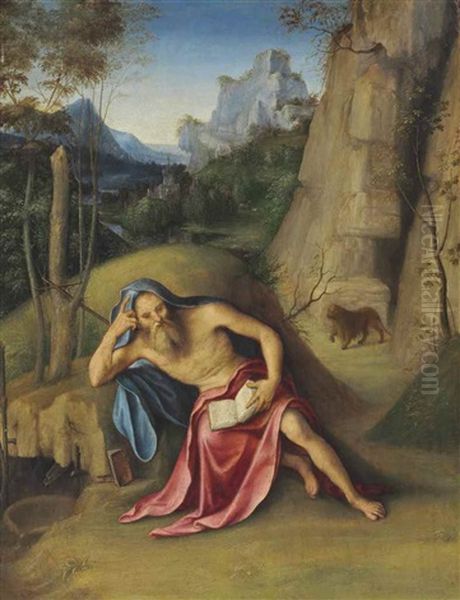
_A Concert_ (c. 1485-1495, National Gallery, London): This enigmatic painting depicts three musicians, possibly including a self-portrait or a portrait of a fellow artist like Francia. The figures are rendered with psychological depth, their introspective expressions creating a palpable sense of mood. The soft lighting and subtle modeling are characteristic of Costa's mature style, and the work has often been compared to the poetic genre scenes of Giorgione, though it may predate some of Giorgione's key works.
_Allegory of the Court of Isabella d'Este_ (or _Coronation of a Lady_) (c. 1504-1506, Musée du Louvre, Paris): Painted for Isabella d'Este's Studiolo, this complex allegorical work is a testament to the humanist culture of the Mantuan court. It depicts a richly populated scene, likely representing Isabella being crowned by Love, surrounded by poets, musicians, and mythological figures. The painting is characterized by its lyrical beauty, graceful figures, and idyllic landscape setting. It shows Costa's ability to translate complex literary and philosophical ideas into visual form.
_Saint Sebastian_ (various versions, e.g., Gemäldegalerie Alte Meister, Dresden): A popular subject in Renaissance art, Costa painted St. Sebastian multiple times. These depictions typically show the saint with a gentle, melancholic expression, his body rendered with anatomical understanding but without excessive drama. The landscapes are often serene, contributing to the overall mood of pious resignation.
Contemporaries and Artistic Exchange
Lorenzo Costa's career unfolded during a period of intense artistic activity and exchange across Italy. His interactions with and awareness of other artists were crucial to his development.
His primary artistic relationship was with Francesco Francia in Bologna. Their long collaboration was a defining feature of Costa's middle period, leading to a mutual softening and enrichment of their respective styles.
In Ferrara, he was heir to the tradition of Cosimo Tura and Ercole de' Roberti. Their influence provided the bedrock of his early artistic formation.
The towering figure of Andrea Mantegna preceded him as court painter in Mantua. While Costa's style differed significantly from Mantegna's stern classicism, he would have undoubtedly studied and respected Mantegna's work, particularly his mastery of perspective and classical motifs.
The influence of Pietro Perugino is evident in the sweetness and harmony of Costa's figures, especially during his Bolognese and early Mantuan periods. Perugino's widespread popularity meant his style was a significant force throughout central and northern Italy. Costa also collaborated with Perugino on the decoration of Isabella d'Este's Studiolo.
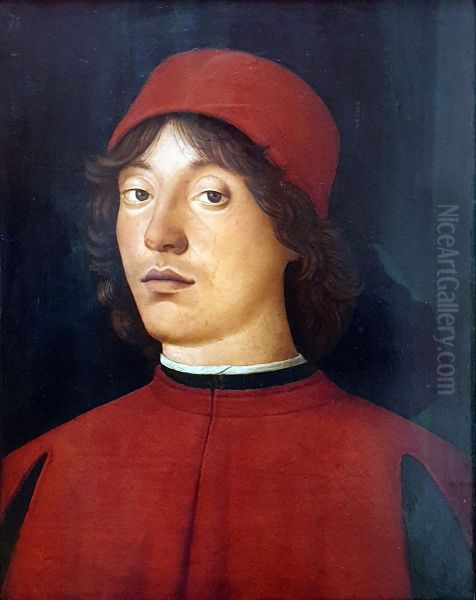
Costa would also have been aware of the developments in Venetian painting, led by Giovanni Bellini, whose atmospheric landscapes and rich colorism were transforming art in the Veneto. The poetic innovations of Giorgione, a younger contemporary, particularly his emphasis on mood and landscape, may have resonated with Costa's own sensibilities, as suggested by works like The Concert.
The High Renaissance masters working in Rome and Florence, such as Leonardo da Vinci, Michelangelo, and Raphael, were also shaping the artistic landscape. While Costa's style remained more rooted in North Italian traditions, the pervasive influence of these giants, particularly Raphael's grace and harmonious compositions, would have been part of the broader artistic consciousness of the time.
In Emilia, Correggio (Antonio Allegri da Correggio) was another significant contemporary, active in nearby Parma. Correggio's work, known for its soft sfumato, dynamic compositions, and tender sentiment, shared some affinities with Costa's later style, though Correggio pushed these qualities to a more sensuous and dramatic extreme. It's plausible that these artists were aware of each other's work, given their geographical proximity and shared artistic currents.
Legacy and Art Historical Significance
Lorenzo Costa's primary legacy lies in his role as a transitional figure who skillfully blended the artistic traditions of Ferrara, Bologna, and Mantua. He helped to soften the sometimes austere Ferrarese style, infusing it with a greater lyricism and emotional sensitivity. His collaboration with Francia was instrumental in shaping the Bolognese school of the late 15th and early 16th centuries.
In Mantua, he continued the tradition of high-quality court painting, adapting his style to the sophisticated tastes of patrons like Isabella d'Este. While perhaps not as revolutionary an innovator as some of his contemporaries, Costa was a consistently accomplished and sensitive artist whose work possesses a distinct charm and quiet beauty.
His influence extended through his sons, Ippolito Costa (1506–1561) and Girolamo Costa, who also became painters, continuing his workshop tradition in Mantua. His grandson, Lorenzo Costa the Younger (1537–1583), son of Girolamo, also carried on the family's artistic name.
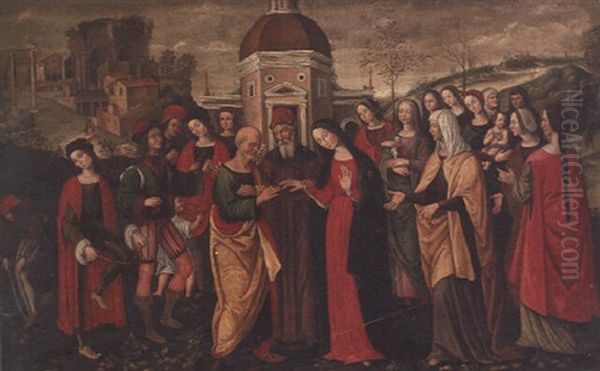
Art historians recognize Lorenzo Costa as an important representative of the North Italian Renaissance. His ability to absorb and synthesize various influences, from the intensity of Ferrara to the grace of Umbria and the sophistication of Mantua, resulted in a body of work that is both diverse and consistently appealing. He played a key role in the artistic developments of the regions where he worked, contributing to a style characterized by gentle humanism, refined technique, and poetic sensibility. His paintings are found in major museums and collections worldwide, attesting to his enduring, if sometimes understated, significance in the history of Italian art.
Conclusion
Lorenzo Costa the Elder was a painter of considerable talent and adaptability, whose career successfully navigated the evolving artistic landscape of Renaissance Italy. From his Ferrarese origins, through his pivotal years in Bologna alongside Francesco Francia, to his prestigious position at the Mantuan court, Costa consistently produced works of high quality, characterized by their gentle emotional appeal, refined execution, and harmonious compositions. He absorbed the influences of masters like Tura, Roberti, Perugino, and was aware of the broader currents exemplified by Bellini and Giorgione, forging a personal style that contributed significantly to the artistic identity of the regions he inhabited. As a bridge between the Early and High Renaissance in Northern Italy, and as a master of conveying subtle human feeling, Lorenzo Costa remains a respected and admired figure in the annals of art history.